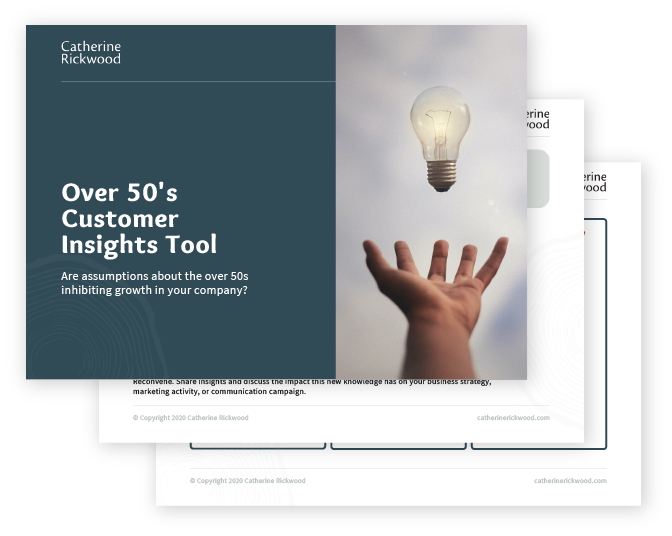Mind the gap.
If you’ve ever caught the London Underground, this cautionary warning would be familiar. ‘Mind the gap’ is also a valuable analogy for customer pain points in business.
A desire to understand and focus on the customer experience (CX) or user experience (UX) is the language of marketers – online or offline. Simultaneously, customer journey mapping has become increasingly common. Yet, how often do we also seek to understand and investigate the challenges of key stakeholders and staff to provide an excellent customer experience – particularly for those customers over 50 years of age? What’s the gap between customer reality and employee empathy?
Whilst a customer focus enables us to better understand the decision-making process of people using or buying our products, stakeholder and staff insights provide greater understanding of what is required internally for improved service delivery. Knowing both is essential if customer pain points are truly to be resolved.
The pain points
Pain points will appear in various parts of the business – either online, on the phone, or in person. An example illustrates some of the issues.
Recently a woman in her 70’s, call her ‘Mary’, told me the difficulties of cancelling her subscription to a television service. After a lengthy conversation with a customer service operator, she was only passed to a supervisor after revealing that she was about to cry.
The pain points:
- The call centre staff member was bound by a script that didn’t accommodate a customer with limited technological ability;
- The process for cancellations was inflexible. Apparently, the only way a customer can cancel the service is online. Consequently, the operator was trained to “talk through” this process with customers who had difficulty;
- A solution was only sought when tears of frustration were imminent.
The result
Mary,
- Won’t have another pay television subscription service;
- Will never return to the telco provider who consistently lacked awareness and empathy;
- Tells her friends and anyone else who will listen about her experiences.
Whilst Mary has a mobile phone, uses an iPad, does online banking, and happily searches Google, she lacks confidence to do new tasks in the online world. The call centre staff member failed to understand Mary’s situation and was therefore unable to accommodate her needs.
Due to years of frustration and poor customer experience caused by a lack of understanding, Mary has also changed her phone provider. In one instance she was sold a plan that provided her with substantial download capacity. However, she had advised staff that her mobile phone was only used for texts and calls. When in the telcos retail stores she consistently observed people her age upset and angry due to lack of empathy by store staff.
Whilst this anecdote is a single sample, it’s a common story.
Gaps and the over 50s
Leading magazines, blogs, and newspapers consistently report on the ignored market of our ageing population.
A report by the Australian Services Union reveals that the average age of call centre staff is between 33 (men) and 37 (women). A report by PwC in 2016 revealed that the average media person is a 27 year old white male who only speaks one language – English. It’s likely that employees under 40 will either ignore or exacerbate stereotypes of consumers over 50. Why? Because they don’t identify with this older age group.
Gaps, facts, and 50’s+
Yet, in Australia, there are almost 6.5 million people between 50 and 74 years of age. That’s 27% of the total population!
The value of this age group is substantial. According to the Australian Bureau of Statistics’ (ABS) 2017 Census, the average age of middle wealth households is 54, and for high wealth households it’s 58. And, whilst a proportion of this wealth is associated with increased expenditure for medical care and health expenses, the ABS also reports that,
“Recreation, household furnishings and equipment, clothing and footwear, and miscellaneous goods and services also rose as net worth rose.”
Consequently, when we evaluate market size against wealth, it seems naive not to have a strategy to reach and effectively service this audience.
Nonetheless, despite these facts, age stereotypes and ageism negatively impact attitudes, beliefs, and perceptions about people over 50.
Finding the gap
A customer journey map is simply a framework that captures the customer experience. A customer journey map overlaid with either staff interviews or staff journey mapping reveals the gap. One without the other is interesting and informative. However, to optimize the opportunity, organisations must ‘Mind the Gap’. The gap is where true opportunity exists.
Given that almost one-third of Australia’s population are baby boomers, it’s remarkable that organisations are not more mindful of this market. After all, chances are that a proportion of most companies’ customers will be in this age bracket. Does your staff understand them? Or, do age stereotypes abound?
Speaking with staff potentially reveals unknown or unspoken age stereotypes. Internal pain points will reveal restrictions that limit market growth with this rapidly expanding segment of the population. Knowing staff attitudes and beliefs about becoming older, coupled with insights on customer pain points has the power to reap rewards – to plug ‘The Gap’.
Closing the Gap
Closing the gap requires guts. Consequently, it means addressing both customer and organisational pain points. For example, staff may need training, processes may need adapting, or organisational structures may constrain service. Change starts with these 4 questions:
- What proportion of your customer base is over 50 years old?
- What’s the impact to your business if they disappeared?
- What proportion of your workforce is under 50 years of age?
- What are their attitudes and beliefs about people over 50? Ask. Answers are usually associated with age-based stereotypes.
If a gap exists then business growth is inhibited.



